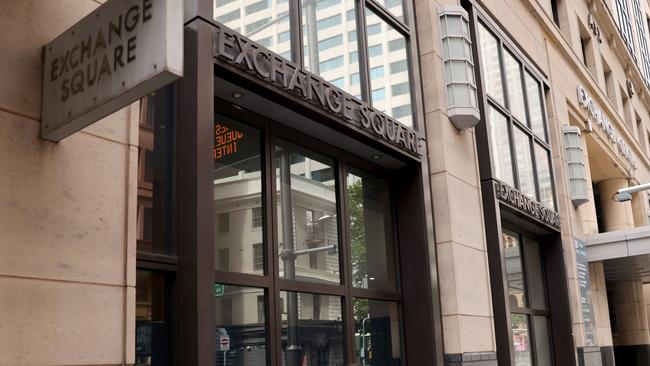Nervous wait for Fed accelerates stocks selling wave
Investors have wiped $59bn off Australian shares as the January rollercoaster intensified before a crucial two-day meeting of the US Federal Reserve.

Investors wiped $59bn off Australian shares on Tuesday as the January rollercoaster intensified before a crucial two-day meeting of the US Federal Reserve despite sharp rebounds on Wall Street.
Blowout inflation data and a slump in business confidence added to jitters before Australia Day.
In its third-biggest percentage fall in the past 17 months and its fifth-biggest fall in the past two years, Australia’s benchmark S&P/ASX 200 share index closed down 178 points or 2.5 per cent at 6961.6 points. The index plunged as much as 3 per cent to an intraday low of 6920.7.
But while the Fed was expected to reinforce expectations that its March meeting will deliver the first of four interest rate hikes expected for this year, its January statement may include some calming words after the US share market suffered its worst week since the Covid panic of March 2020.
“The best time to buy the market is in the January sell-off, so around now,” said Bell Potter’s head of institutional sales and trading, Richard Coppleson.
He noted that the value of shares traded on the Australian market on Tuesday was a massive $12bn.
“Value was what you see when the market is capitulating,” Mr Coppleson said.
Tuesday’s sell-off followed a sharp 2.3 per cent decline last Friday on high volume worth $11bn.
“This is great to see as weak holders are dumping,” he said.
Shaw & Partners institutional trader James Nicolaou noted that 62 listed companies hit 52-week lows as the New Year sell-off in Australian shares accelerated on Tuesday.
On Wall Street, the global flagship S&P 500 fell 4 per cent on Monday before closing up 0.3 per cent.
Heavyweight financials shares were the main drags on the market on Tuesday.
The big four banks and Macquarie Group dived 2 to 3.6 per cent.
Citi analyst Brendan Sproules cautioned that a highly competitive home loans market will potentially offset any favourable impact on net interest margins from rising interest rates.
Energy, information technology, real estate and materials stocks have also underperformed.
Santos dived 4.8 per cent, Woodside Petroleum lost 4 per cent, WiseTech dropped 6.6 per cent, Block Inc fell 4.2 per cent, Dexus tumbled 5.1 per cent and Fortescue Metals lost 5 per cent.
While all sectors of the market fell, A2 Milk soared 7.1 per cent on takeover speculation and Codan jumped 17 per cent after predicting a 21 per cent rise in its first-half profit to $50 million.
Tuesday’s surprisingly sharp fall also came as global equities and commodities dived not just amid expectations of US rate hikes but also escalating geopolitical tensions in Ukraine.
Regional markets dived despite Monday’s huge intraday rebound on Wall Street.
Japan’s Nikkei 225 fell 1.7 per cent, China’s Shanghai Composite fell 1.9 per cent, the Hang Seng lost 1.7 per cent, South Korea’s KOSPI dropped 2.6 per cent and Taiwan’s TAIEX lost 1.6 per cent.
IG market analyst Kyle Rodda said the short-term outlook now hinged on the outcome of the Fed meeting, which is due to conclude about 6am AEDT Thursday Australian time.
Whereas Monday’s bounce on Wall Street suggested “the bottom was in”, he cautioned that Tuesday’s price action seemed to suggest it “could be just dead-cat bounce”.
“At the moment, either could be true, because it won’t be until some clarity is given by the Fed about its policy intentions that markets may settle down,” Mr Rodda said.
“If the central bank is less hawkish than is currently priced-in, then risk could recover. If not, this level of volatility may well persist for a little longer yet.”
He said the impact of potentially higher rates on asset prices was rammed home by higher Australian CPI data, with headline and core measures well above expectations.
“Given that the surge in demand post-lockdowns and escalating costs pressures are likely to add to the inflation pulse in coming quarters, the data was another cue that the RBA will have to tighten policy materially in the year ahead,’’ Mr Rodda said.
“The market is well and truly pricing in four rate hikes this year, with the first now quite likely to come in May, and QE is all but certain to be wrapped up next week.”
Avatrade chief market analyst Naeem Aslam said that after the significant drops in the share market in recent weeks, investors may now feel that stocks are undervalued.
At Monday’s lows, the S&P 500 had fallen 12 per cent from a record high daily close reached on January 3, putting it into “correction” territory.
The Nasdaq 100 index fell as much as 18.4 per cent from its record high daily close set in November, putting it close to the 20 per cent “bear market” marker, which may draw attention from the Fed.
The widely watched VIX index of volatility on S&P 500 futures hit a 15-month high of 38.94 per cent on Monday compared with its long-term average of 19 per cent, before closing at 29.9 per cent.
“Having said that, as we are expecting various economic reports this week along with the Fed’s monetary policy, stockmarkets are likely to remain volatile over the next few days,” Mr Aslam said.
“The main issue that investors are facing is trying to understand what the aggressive pace of winding down the Fed’s quantitative measures would mean for valuations of companies and global financial markets (and) rising geopolitical tensions in the Middle East and Ukraine may also cause waves of uncertainty among investors.”
But despite the rise in uncertainty and risks, he expected support from the US corporate earnings season.
Microsoft was due to report after the close of US trading on Tuesday and Johnson & Johnson, Verizon, and American Express are also scheduled to release their earnings reports.
Tesla and Apple were due to report later this week.




